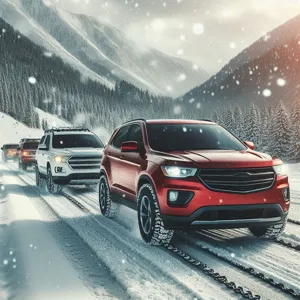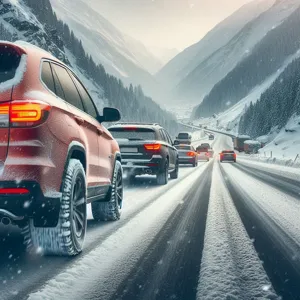In a world where safety on the road is more crucial than ever, choosing the right vehicle can make all the difference for you and your loved ones.
With technological advancements and innovative design, the automotive industry has made significant strides in enhancing vehicle safety features. This year, 2023 brings a fresh lineup of cars equipped with state-of-the-art safety technology, robust structures, and advanced driver-assistance systems designed to protect occupants in the event of an accident. In this blog post, we’ll explore the top 10 safest cars of 2023, highlighting their standout safety features, crash test ratings, and the peace of mind they offer. Whether you’re a new parent, a seasoned commuter, or simply someone who values safety, our comprehensive guide will help you make an informed decision when it comes to choosing a car that prioritizes your well-being on the road. Join us as we dive into the best options available this year, ensuring that every drive is a secure one.
1. Introduction: The Importance of Vehicle Safety

In an era where technology and innovation continuously shape the automotive landscape, the importance of vehicle safety cannot be overstated. Every day, millions of people rely on their cars to transport them to work, school, and leisure activities, making it essential to prioritize safety features that protect not only the driver but also passengers and pedestrians alike. As we navigate through busy roads, the potential for accidents looms large, underscoring the need for vehicles designed with advanced safety measures.
In 2023, the automotive industry has made remarkable strides in safety technology, integrating features such as adaptive cruise control, automatic emergency braking, lane-assist systems, and advanced airbag configurations. These innovations are designed to minimize the risk of collisions and enhance driver awareness, ultimately saving lives. However, with a plethora of options available in the market, distinguishing which vehicles truly excel in safety can be overwhelming.
This blog post aims to shed light on the top 10 safest cars of 2023, showcasing models that have undergone rigorous testing and received high safety ratings from leading organizations. Whether you’re a new parent looking for a family-friendly vehicle, a commuter seeking peace of mind on the road, or simply someone who values the well-being of loved ones, our list will help guide you toward making a well-informed decision. After all, when it comes to choosing a vehicle, safety should always take precedence. Join us as we explore the safest vehicles of the year and learn about the features that set them apart in the quest for ultimate protection.
2. Overview of Safety Ratings and Standards
When it comes to choosing a vehicle, safety ratings and standards are paramount, especially for families looking to protect their loved ones on the road. In 2023, the automotive industry continues to prioritize safety, with rigorous testing and evaluation processes established by organizations such as the National Highway Traffic Safety Administration (NHTSA) and the Insurance Institute for Highway Safety (IIHS). These entities conduct extensive crash tests and assessments to determine how well vehicles can withstand various types of collisions and protect occupants.
Safety ratings are typically expressed in star ratings or a score system, making it easier for consumers to compare vehicles. For instance, the NHTSA uses a five-star rating system, where five stars indicate exceptional safety performance. Meanwhile, the IIHS evaluates vehicles based on several criteria, including crashworthiness, crash avoidance, and child seat anchors, awarding ratings such as “Top Safety Pick” and “Top Safety Pick+” to those that excel in their tests.
In 2023, advancements in technology have also played a crucial role in enhancing vehicle safety. Features such as automatic emergency braking, lane departure warning, and adaptive cruise control are becoming standard in many new models, further influencing safety ratings. As manufacturers incorporate these technologies, consumers can feel more confident that their chosen vehicle is equipped to handle the unexpected on the road.
When considering your next car purchase, it’s essential to delve into these safety ratings and standards. Not only do they provide valuable insight into a vehicle’s crash performance, but they also highlight the latest innovations designed to keep you and your passengers safe. By placing safety at the forefront of your decision-making process, you can ensure peace of mind while driving, knowing that you’ve chosen one of the safest vehicles available in 2023.
3. Criteria for Selecting the Safest Cars

When it comes to choosing the safest cars of 2023, a comprehensive set of criteria is essential to ensure that both drivers and passengers are well-protected on the road. The landscape of automotive safety has evolved dramatically in recent years, and several key factors contribute to the evaluation of a vehicle’s safety profile.
**Crash Test Ratings:** One of the primary considerations is the vehicle’s performance in crash tests conducted by organizations such as the National Highway Traffic Safety Administration (NHTSA) and the Insurance Institute for Highway Safety (IIHS). These tests assess how well a vehicle protects its occupants during various types of collisions. High ratings in front and side impact tests, as well as roof strength evaluations, are indicative of a car’s ability to safeguard its passengers.
**Advanced Safety Features:** The presence of advanced safety technology is another critical criterion. Features such as automatic emergency braking, lane-keeping assist, adaptive cruise control, and blind-spot monitoring play a significant role in accident prevention. Cars equipped with these tools not only help mitigate the consequences of potential collisions but also actively work to avoid them altogether.
**Structural Integrity:** The design and materials used in a vehicle’s construction are vital for ensuring its structural integrity in the event of an accident. Manufacturers that utilize high-strength steel and innovative crumple zone designs enhance a vehicle’s ability to absorb energy during a crash, thereby protecting occupants.
**Child Safety Ratings:** For families, child safety is a paramount concern. Evaluating how well a car accommodates car seats and the availability of LATCH (Lower Anchors and Tethers for Children) systems can significantly impact the safety of younger passengers. Additional considerations include rear door child locks and the ease of accessing the rear seats.
**Real-World Safety Data:** Finally, analyzing real-world safety data and statistics can provide valuable insights into a vehicle’s safety performance. This includes examining reports on accident rates, injury claims, and insurance data, offering a broader perspective on how a car holds up in everyday driving scenarios.
By meticulously assessing these criteria, consumers can make informed decisions when selecting a vehicle that not only meets their needs but also prioritizes the safety of everyone on board. In a world where safety is paramount, understanding what makes a car safe can ensure peace of mind for you and your loved ones every time you hit the road.
4. The Top 10 Safest Cars of 2023
When it comes to choosing a car, safety is often at the forefront of every buyer’s mind. In 2023, automotive manufacturers have stepped up their game, integrating advanced safety technologies and rigorous crash test standards to ensure that vehicles not only protect their occupants but also pedestrians and other road users. Here, we delve into the top 10 safest cars of the year, showcasing models that have excelled in safety ratings, equipped with innovative features designed to prevent accidents and enhance overall protection.
1. **volvo XC90**
Renowned for its commitment to safety, the Volvo XC90 continues to lead the way. With a robust suite of driver assistance technologies, including pilot assist and emergency braking, this luxury SUV combines comfort with top-tier protection.
2. **Tesla Model 3**
A beacon of electric innovation, the Tesla Model 3 not only minimizes emissions but also maximizes safety. Its unique design allows for a low center of gravity, reducing rollover risk, while its autopilot system enhances driver awareness and control.
3. **Subaru Outback**
The Subaru Outback is synonymous with all-terrain capability and safety. With its standard EyeSight Driver Assist Technology and a strong reputation for crashworthiness, it’s an ideal choice for families who love adventure.
4. **Honda Accord**
A perennial favorite in the sedan category, the Honda Accord boasts an impressive suite of safety features such as lane-keeping assist and adaptive cruise control. Its solid frame and multiple airbags provide peace of mind for both drivers and passengers.
5. **Mazda CX-5**
The Mazda CX-5 shines not just in aesthetics but also in safety. It includes advanced safety features like Smart City Brake Support and rear cross-traffic alert, making it a stylish yet secure choice for urban driving.
6. **Hyundai Elantra**
The compact Hyundai Elantra may be small, but it comes packed with protective technology. With its forward collision-avoidance assist and lane-following assist, this car checks all the boxes for safety in a budget-friendly package.
7. **Ford Bronco**
A rugged contender, the Ford Bronco combines classic design with modern safety enhancements. Its high-strength steel frame and comprehensive airbag system provide robust protection, making it an excellent choice for off-road enthusiasts.
8. **Kia Telluride**
The Kia Telluride has quickly gained popularity for its spacious interior and safety features. With sophisticated systems like blind-spot monitoring and a rearview camera, this SUV ensures that families are well-protected on the road.
9. **Toyota Camry**
A staple in the mid-size sedan market, the Toyota Camry comes equipped with Toyota Safety Sense, which includes pre-collision systems and adaptive cruise control. Its reliable performance and safety integrity make it a trusted choice for drivers everywhere.
10. **Acura MDX**
The Acura MDX stands out with its luxurious feel and advanced safety technology. With features like collision mitigation braking and lane departure warning, it offers a blend of sophistication and secure driving for those who prioritize safety.
These vehicles not only meet stringent safety standards but also offer peace of mind for drivers and passengers alike. As technology evolves, so does the promise of safer roads, and in 2023, these top contenders exemplify that commitment to safety in every journey.
– 4.1. Car #1: Model and Key Safety Features

### 4.1. Car #1: Volvo XC90
When it comes to safety, the Volvo XC90 has long stood as a benchmark in the automotive world, and the 2023 model is no exception. This luxury midsize SUV combines elegant design with an impressive array of safety features, ensuring that both the driver and passengers experience unparalleled protection on the road.
One of the standout safety features of the XC90 is its advanced suite of driver assistance technologies. Equipped with Volvo’s Pilot Assist, the XC90 offers semi-autonomous driving capabilities, allowing for smooth acceleration, braking, and steering on well-marked highways. This feature not only reduces driver fatigue but also minimizes the risk of accidents caused by momentary lapses in attention.
The XC90 is also outfitted with a comprehensive collision avoidance system that includes adaptive cruise control, lane-keeping assistance, and blind-spot monitoring. These systems work in tandem to keep you aware of your surroundings and to intervene when necessary, helping to prevent potential collisions.
In addition to its technological advancements, the Volvo XC90 is built with a robust safety architecture, designed to absorb and dissipate energy during a crash. It features a high-strength steel frame, along with strategically placed crumple zones that help protect occupants in the event of a collision.
Moreover, the XC90’s interior is designed with safety in mind. It boasts multiple airbags, including side-curtain airbags that extend to all three rows, providing maximum protection for every passenger. The car also incorporates child safety features, such as ISOFIX and LATCH anchors, making it easier to secure child seats and ensuring the little ones are safely buckled in.
Overall, the 2023 Volvo XC90 represents the pinnacle of automotive safety, merging cutting-edge technology with a commitment to protecting you and your loved ones. Whether you’re navigating busy city streets or embarking on a family road trip, this vehicle stands out as a top choice for those prioritizing safety without compromising on style and comfort.
– 4.2. Car #2: Model and Key Safety Features
### 4.2. Car #2: Volvo XC90
The Volvo XC90 continues to uphold its reputation as one of the safest vehicles on the road, a testament to the brand’s unwavering commitment to passenger protection. With a sleek and sophisticated design, this luxury SUV is not only visually striking, but it also boasts an impressive suite of advanced safety features that prioritize the well-being of both driver and passengers.
At the heart of the XC90’s safety offerings is its robust structure, designed to absorb and disperse energy in the event of a collision. The vehicle is equipped with an array of airbags, including front, side, and curtain airbags, providing comprehensive protection from all angles. Additionally, its state-of-the-art anti-lock braking system (ABS) and electronic stability control (ESC) work in tandem to enhance vehicle stability during sudden maneuvers, significantly reducing the risk of accidents.
One of the standout features of the Volvo XC90 is its innovative Pilot Assist technology, which offers semi-autonomous driving capabilities. This system helps keep the vehicle centered in its lane while maintaining a safe distance from the car ahead, making highway driving more comfortable and secure. Coupled with adaptive cruise control, the XC90 takes the stress out of long journeys and ensures a more relaxed driving experience.
Furthermore, the XC90 is equipped with the City Safety feature, which utilizes advanced sensors to detect potential collisions with vehicles, pedestrians, and cyclists. In the event of an imminent crash, the system can automatically apply the brakes, potentially preventing or mitigating the severity of an accident. This proactive approach to safety is a hallmark of Volvo’s design philosophy, ensuring that the XC90 not only reacts to dangers but actively works to avoid them.
In addition to these standout safety features, the XC90 offers a comprehensive suite of driver-assistance systems, including blind-spot monitoring, rear cross-traffic alert, and lane-keeping assistance. These technologies provide an added layer of security, giving drivers the confidence they need to navigate busy roads.
With its blend of luxury, performance, and cutting-edge safety technology, the Volvo XC90 remains a top choice for families who prioritize protection without compromising on style or comfort. Whether you’re commuting through city streets or embarking on a weekend getaway, the XC90 ensures that you and your loved ones are shielded from harm, making it one of the safest cars of 2023.
– 4.3. Car #3: Model and Key Safety Features

### 4.3. Car #3: Volvo XC90
The Volvo XC90 stands as a paragon of safety and sophistication in the SUV market, earning its place among the top safest cars of 2023. With its iconic Scandinavian design and robust build, this vehicle not only prioritizes style but also the well-being of its occupants. The XC90 is equipped with an array of advanced safety features that exemplify Volvo’s commitment to protecting you and your loved ones.
One of the standout features of the XC90 is its comprehensive suite of driver-assistance technologies, dubbed IntelliSafe. This system includes adaptive cruise control, lane-keeping assistance, and collision avoidance systems that actively monitor the road and provide alerts to help prevent accidents. The vehicle’s automatic emergency braking function is particularly noteworthy, as it can detect potential collisions with other vehicles, pedestrians, or cyclists, and will apply the brakes if the driver fails to respond in time.
Moreover, the XC90 boasts a rigorous crash test rating, consistently scoring high in both frontal and side-impact tests. Its solid structure, combined with crumple zones and a reinforced passenger cabin, ensures that in the event of a collision, the safety of the occupants is prioritized. The vehicle is also equipped with multiple airbags strategically placed throughout the cabin, providing an additional layer of protection.
Inside, the XC90 offers not only luxury and comfort but also peace of mind with its child safety features. The built-in booster seats and ISOFIX anchor points make it easy to secure little ones safely, allowing parents to travel confidently.
With its blend of cutting-edge safety technology, robust construction, and family-friendly design, the Volvo XC90 embodies what it means to be a safe vehicle in today’s automotive landscape. It’s a formidable choice for those who prioritize safety without compromising on style or comfort, ensuring that you and your loved ones traverse the roads with the utmost protection.
– 4.4. Car #4: Model and Key Safety Features
### 4.4. Car #4: Volvo XC90
The 2023 Volvo XC90 stands as a beacon of safety in the SUV segment, renowned for its robust build quality and advanced safety technologies. This luxury midsize SUV not only offers a stylish and comfortable ride but is also engineered with a commitment to keeping you and your loved ones secure on the road.
One of the standout features of the XC90 is its comprehensive suite of safety systems, known as the Volvo IntelliSafe package. This includes a state-of-the-art collision avoidance system that uses radar and cameras to detect potential hazards. The system can automatically apply the brakes if it senses an impending collision, providing an extra layer of security for both drivers and pedestrians.
Additionally, the XC90 is equipped with blind-spot monitoring, which alerts drivers to vehicles lurking in their blind spots, and lane-keeping assistance, ensuring you stay centered in your lane. The SUV’s adaptive cruise control is designed to maintain a safe distance from the vehicle ahead, automatically adjusting your speed in response to traffic conditions.
Volvo’s signature safety innovation, the Safety Cage, utilizes high-strength steel and strategically placed crumple zones to absorb impact energy, protecting passengers in the event of a collision. The XC90 also boasts multiple airbags, including side-curtain airbags that extend to protect third-row passengers—a testament to Volvo’s commitment to safety for all occupants.
With its impressive crash test ratings and an array of cutting-edge safety features, the 2023 Volvo XC90 not only epitomizes luxury but also stands firm as one of the safest vehicles on the market, ensuring peace of mind for families and individuals alike. Whether you’re navigating city streets or embarking on a family road trip, the XC90 is designed to provide a secure and confident driving experience.
– 4.5. Car #5: Model and Key Safety Features
### 4.5. Car #5: Volvo XC90
When it comes to safety, the 2023 Volvo XC90 stands out as a beacon of engineering excellence and an embodiment of the brand’s commitment to protecting both drivers and passengers. This luxury SUV has consistently earned high marks in crash tests, and its innovative safety features are designed to mitigate risks and enhance driver awareness.
The XC90 comes equipped with an impressive array of safety technologies. Its advanced **City Safety Collision Avoidance Technology** uses a combination of radar and cameras to detect potential collisions with other vehicles, pedestrians, and cyclists, automatically applying the brakes when necessary. This feature is particularly beneficial in urban environments, where unexpected obstacles can appear at any moment.
Another highlight is the **Pilot Assist system**, which provides semi-autonomous driving capabilities. This system helps maintain a safe distance from the car ahead while keeping you centered in your lane, significantly reducing driver fatigue during long journeys. Additionally, the **Blind Spot Information System (BLIS)** alerts drivers to vehicles in their blind spots, enhancing lane-change safety.
The XC90 doesn’t compromise on structural integrity either. Its high-strength steel frame and crumple zones absorb impact energy during a collision, protecting occupants within. Furthermore, the vehicle is equipped with multiple airbags, including side-curtain airbags that deploy to shield passengers in the event of a side impact.
With its commitment to safety, luxurious comfort, and cutting-edge technology, the 2023 Volvo XC90 not only protects you and your loved ones on the road but also elevates your driving experience to new heights. Whether navigating crowded city streets or cruising along scenic highways, this SUV ensures you can travel with peace of mind, knowing that safety is always a priority.
– 4.6. Car #6: Model and Key Safety Features
### 4.6. Car #6: Volvo XC90
The 2023 Volvo XC90 stands out as a beacon of safety in the luxury SUV segment, consistently earning top marks in crash tests and safety ratings. This family-friendly vehicle is designed with both comfort and security in mind, making it an ideal choice for those who prioritize the well-being of their loved ones on the road.
**Key Safety Features:**
1. **Pilot Assist:** This semi-autonomous driving aid significantly reduces driver fatigue by helping with steering, acceleration, and braking on well-marked highways. It promotes a safer driving experience, allowing the driver to focus more on the road.
2. **City Safety Collision Avoidance Technology:** This innovative system uses advanced sensors to detect potential collisions with other vehicles, pedestrians, cyclists, and large animals. If a collision is imminent, the XC90 can automatically apply the brakes, helping to prevent or mitigate accidents.
3. **Blind Spot Information System (BLIS):** The XC90 is equipped with BLIS, which provides visual alerts in the side mirrors when vehicles enter your blind spots, enhancing lane-change safety and preventing potential side collisions.
4. **360-Degree Surround View Camera:** This feature offers a comprehensive view of the surroundings, making parking and maneuvering in tight spaces easier and safer. It gives drivers confidence by eliminating blind spots that could lead to accidents.
5. **Advanced Airbag System:** With multiple airbags strategically placed throughout the cabin, the XC90 ensures that all passengers are well-protected in the event of a collision, reducing the risk of injury.
6. **Run-Off Road Protection:** This unique feature helps prevent rollover accidents by sensing when the vehicle is about to leave the road. It can tighten the seatbelts and adjust the seating position to better protect occupants during a potential crash.
With its suite of safety technologies and a commitment to passenger protection, the 2023 Volvo XC90 exemplifies what it means to be a safe vehicle on the road. It seamlessly combines advanced engineering with a touch of luxury, ensuring that you and your loved ones can travel with peace of mind, no matter the destination.
– 4.7. Car #7: Model and Key Safety Features
### 4.7. Car #7: Volvo XC90
The Volvo XC90 continues to be a standout in the realm of safety, embodying the brand’s long-standing commitment to protecting drivers and passengers alike. As a midsize luxury SUV, it combines elegant design with cutting-edge safety features, making it a top choice for families and safety-conscious individuals.
**Key Safety Features:**
1. **Pilot Assist**: This advanced driver assistance feature provides steering assistance and adaptive cruise control, helping to maintain a safe distance from other vehicles while keeping you centered in your lane. It’s an invaluable tool for reducing stress during long drives or in heavy traffic.
2. **City Safety Collision Avoidance Technology**: Volvo’s innovative City Safety system uses radar and cameras to detect potential collisions with vehicles, pedestrians, cyclists, and large animals. If a collision is imminent, the system can automatically apply the brakes, significantly reducing the risk of accidents.
3. **Blind Spot Information System (BLIS)**: With BLIS, you’ll receive alerts if there’s a vehicle in your blind spot, making lane changes safer and more informed. This feature not only enhances your awareness but also provides peace of mind when navigating busy highways.
4. **360-Degree Surround View Camera**: Maneuvering in tight spaces becomes effortless with the XC90’s surround view camera, which provides a bird’s-eye view of your surroundings. This feature is particularly beneficial for parking and navigating through crowded areas.
5. **Advanced Airbag System**: The XC90 is equipped with a comprehensive airbag system, including front, side, and curtain airbags that deploy in the event of a collision, offering robust protection for all occupants.
6. **Road Sign Information**: This feature keeps you updated on speed limits and other important road signs, displaying them on the driver’s display, ensuring you stay informed and compliant with traffic laws.
The Volvo XC90 doesn’t just prioritize safety; it also offers a luxurious driving experience with a spacious interior, premium materials, and an intuitive infotainment system. With its blend of safety technology and comfort, the XC90 stands out as a compelling choice for those looking to protect what matters most while enjoying the journey.
– 4.8. Car #8: Model and Key Safety Features
### 4.8. Car #8: Volvo XC90
The Volvo XC90 continues to uphold its reputation as a frontrunner in automotive safety, embodying the brand’s commitment to protecting both drivers and passengers. This luxury SUV seamlessly blends sophisticated design with an impressive array of safety features, making it a top choice for families and safety-conscious individuals alike.
One of the standout features of the XC90 is its advanced driver assistance systems, which include the renowned Pilot Assist technology. This semi-autonomous feature can help with steering, acceleration, and braking, allowing for smoother highway driving while reducing the risk of collisions. Additionally, the SUV is equipped with a comprehensive suite of sensors and cameras that power the City Safety system, which actively detects pedestrians, cyclists, and other vehicles, providing automatic emergency braking when necessary.
The XC90 also shines in its crashworthiness. With a robust frame and multiple airbags strategically positioned throughout the cabin, it has consistently earned top marks in crash tests conducted by safety organizations. Furthermore, the SUV boasts excellent visibility thanks to its large windows and advanced lighting systems, ensuring that drivers can see and be seen on the road.
Inside, the XC90 prioritizes passenger safety without compromising on comfort. The spacious interior is designed with high-quality materials, and the seating configuration allows for easy access to child safety seats, making it an ideal choice for families. With its combination of cutting-edge technology, proven safety features, and thoughtful design, the Volvo XC90 stands out as one of the safest cars of 2023, ensuring peace of mind for you and your loved ones.
– 4.9. Car #9: Model and Key Safety Features
### 4.9. Car #9: Toyota Camry
The 2023 Toyota Camry continues to be a standout in the midsize sedan category, not just for its reliability and performance but also for its impressive safety credentials. This vehicle has consistently earned high marks in crash tests, making it a trusted choice for families and individuals alike.
Equipped with Toyota’s Safety Sense suite, the Camry boasts a range of advanced safety features designed to protect occupants and prevent accidents. Key features include:
– **Pre-Collision System with Pedestrian Detection**: This innovative system uses cameras and radar to detect vehicles and pedestrians in your path. If a potential collision is detected, the system can alert the driver and, if necessary, apply the brakes autonomously to prevent or mitigate an impact.
– **Lane Departure Alert with Steering Assist**: The Camry helps keep you centered in your lane with its lane departure alert that warns you when you unintentionally drift. If necessary, the steering assist can provide gentle corrections to help guide you back into your lane.
– **Dynamic Radar Cruise Control**: This feature adjusts your speed to maintain a safe distance from the vehicle in front of you, providing a more relaxed driving experience on long trips and in heavy traffic.
– **Blind Spot Monitor with Rear Cross-Traffic Alert**: The blind spot monitor helps you change lanes safely by alerting you if there are vehicles in your blind spots. Meanwhile, the rear cross-traffic alert warns you of approaching traffic when you’re backing out of a parking space.
With these robust safety features, the Toyota Camry not only prioritizes the well-being of its passengers but also enhances the overall driving experience. Its solid construction, coupled with innovative technology, positions it as a top contender among the safest cars of 2023, ensuring peace of mind for you and your loved ones on every journey.
– 4.10. Car #10: Model and Key Safety Features
#### 4.10. Car #10: Volvo XC90
As we delve into the top tier of safety for 2023, the Volvo XC90 stands out as our tenth safest car, embodying the brand’s long-standing commitment to prioritizing passenger protection. This luxury SUV showcases a blend of sophisticated design and advanced safety technology, making it a formidable choice for families and individuals alike.
**Key Safety Features:**
1. **Pilot Assist**: This semi-autonomous driving system offers steering assistance, adaptive cruise control, and lane-keeping aid, providing an extra layer of security on long journeys and in heavy traffic.
2. **City Safety Collision Avoidance Technology**: This innovative system uses advanced sensors to detect potential collisions with vehicles, pedestrians, cyclists, and even large animals. If a possible impact is detected, the system can automatically apply the brakes, helping to prevent accidents before they happen.
3. **Run-off Road Protection**: This unique feature is designed to mitigate the risks associated with unintentional lane departures. If the vehicle leaves the road, the XC90 can automatically tighten the seatbelts and employ special interventions to protect occupants in the event of a rollover.
4. **360-Degree Camera System**: Offering a bird’s-eye view of the surrounding environment, this feature enhances visibility and awareness while parking or maneuvering in tight spaces, making it easier to avoid obstacles and potential hazards.
5. **Advanced Airbag System**: The XC90 is equipped with a comprehensive airbag system, including side curtains and thorax airbags, that provide vital protection in the event of a collision.
6. **Blind Spot Information System (BLIS)**: This feature alerts drivers to vehicles in their blind spots, significantly reducing the risk of side collisions during lane changes.
In addition to these impressive safety features, the Volvo XC90 is designed with a robust frame and crumple zones that absorb impact energy, ensuring that you and your loved ones are well-protected in any situation. With its luxurious interior and state-of-the-art technology, the XC90 not only offers peace of mind but also a comfortable and enjoyable driving experience, making it a worthy contender in the safest cars of 2023.
5. Advanced Safety Technologies to Look For
In the rapidly evolving world of automotive engineering, advanced safety technologies have emerged as critical features that can significantly enhance the protection of you and your loved ones on the road. When shopping for a new vehicle, it’s essential to understand these innovations and how they contribute to overall safety.
**1. Automatic Emergency Braking (AEB):** This lifesaving technology detects an impending collision and automatically applies the brakes if the driver fails to respond in time. AEB has been proven to reduce rear-end crashes significantly, making it a must-have feature for any family vehicle.
**2. Adaptive Cruise Control (ACC):** More than just a convenience feature, ACC helps maintain a safe distance from the vehicle ahead by automatically adjusting your speed. This capability is especially beneficial for long highway trips, allowing for a more relaxed driving experience while still prioritizing safety.
**3. Lane Keeping Assist (LKA):** Lane departure warnings can alert you when you’re drifting from your lane, but LKA takes it a step further by gently steering the vehicle back into its lane. This technology helps prevent potential accidents caused by driver distraction or fatigue.
**4. Blind Spot Monitoring (BSM):** Changing lanes can be a nerve-wracking experience, but BSM systems help by alerting you to vehicles in your blind spots. With visual or audible warnings, these systems enhance situational awareness and bolster confidence when navigating busy roads.
**5. 360-Degree Camera Systems:** Parking and maneuvering in tight spaces can be challenging, but a 360-degree camera system provides a bird’s-eye view of your vehicle’s surroundings. This comprehensive perspective aids in avoiding obstacles and ensures safer parking, making it ideal for urban environments.
**6. Traction and Stability Control Systems:** These systems work tirelessly to prevent wheel slip during acceleration or on slippery surfaces. By monitoring wheel speed and adjusting engine power or brake force, they help maintain control in adverse weather conditions, giving drivers peace of mind.
**7. Advanced Airbag Systems:** Traditional airbags are now often complemented by advanced systems that adapt to the severity of a collision. Features such as side curtain airbags and knee airbags further enhance protection for all passengers, ensuring that safety is prioritized in every possible way.
As you consider your options among the safest cars of 2023, be sure to weigh the presence and effectiveness of these advanced safety technologies. They not only make driving more secure but also provide an invaluable sense of reassurance for you and your loved ones, transforming everyday journeys into safer experiences.
6. The Role of Crash Test Ratings
When it comes to choosing a vehicle that ensures the safety of you and your loved ones, crash test ratings play a pivotal role. These ratings, conducted by reputable organizations such as the National Highway Traffic Safety Administration (NHTSA) and the Insurance Institute for Highway Safety (IIHS), provide invaluable insights into how well a car performs in various collision scenarios.
Crash tests simulate real-world accidents, evaluating how vehicles handle impacts from different angles and the effectiveness of safety features like airbags, seatbelts, and structural integrity. The results are typically expressed in star ratings or letter grades, allowing consumers to easily compare the safety performance of different models. A higher rating signifies better protection, indicating that the vehicle is engineered to absorb impact and safeguard its occupants.
Beyond just numbers, these ratings reflect extensive research and rigorous testing, offering peace of mind that you’re making an informed decision. For instance, vehicles that achieve top ratings often incorporate advanced safety technologies, such as automatic emergency braking, lane departure warning, and stability control, all designed to minimize the risk of accidents before they occur.
As you explore your options for the safest cars of 2023, remember that crash test ratings should be a cornerstone of your research. A car that excels in these tests is not just a good choice; it’s an investment in the safety and well-being of everyone on board. By prioritizing vehicles with high crash test ratings, you can drive with confidence, knowing that you are taking proactive steps to protect yourself and your loved ones on the road.
7. Real-World Safety Performance: What the Data Says
When it comes to choosing a vehicle, raw specifications and flashy features are only part of the equation. Real-world safety performance is where the rubber meets the road, and understanding the data behind crash tests and safety ratings can provide invaluable insights into how well a car can protect you and your loved ones in the event of an accident.
In 2023, various organizations, such as the National Highway Traffic Safety Administration (NHTSA) and the Insurance Institute for Highway Safety (IIHS), have released comprehensive safety reports that delve into the performance of vehicles in real-world scenarios. These assessments go beyond laboratory tests, focusing on how cars perform in actual accidents, taking into account factors such as crashworthiness, collision avoidance, and the effectiveness of safety features.
For instance, the IIHS rates vehicles based on their performance in various crash tests, including small overlap front, moderate overlap front, side, roof strength, and head restraints. Cars that excel in these tests typically receive top ratings, indicating they are well-engineered to withstand impacts and protect occupants. Additionally, the NHTSA conducts rigorous evaluations, providing star ratings that help consumers quickly gauge a vehicle’s safety.
Beyond crash test data, real-world safety performance also considers how well vehicles are equipped with advanced driver-assistance systems (ADAS), such as automatic emergency braking, lane-keeping assist, and adaptive cruise control. These technologies not only help prevent accidents but can significantly reduce the severity of collisions when they do occur. By delving into the data and research surrounding these safety features, consumers can make more informed decisions and select vehicles that not only meet safety standards but exceed them.
In 2023, the safest cars on the market are those that combine stellar crash test ratings with cutting-edge technology, ensuring that you can drive with confidence, knowing that your vehicle is designed to keep you and your loved ones out of harm’s way. As you explore your options, remember to consider the data that reflects real-world performance—because when it comes to safety, numbers don’t lie.
8. Tips for Choosing a Safe Vehicle for Your Family
When it comes to choosing a safe vehicle for your family, the decision can feel overwhelming given the myriad of options available. However, prioritizing safety doesn’t have to be a daunting task. Here are some practical tips to guide you in selecting a vehicle that will protect both you and your loved ones.
**1. Look for Crash Test Ratings:** Start your research by checking crash test ratings from reputable organizations such as the National Highway Traffic Safety Administration (NHTSA) and the Insurance Institute for Highway Safety (IIHS). These ratings provide valuable insights into how vehicles perform in various crash scenarios. A high rating is a strong indicator of a car’s safety features and overall reliability.
**2. Prioritize Advanced Safety Features:** Modern vehicles come equipped with an array of advanced safety technologies designed to prevent accidents and protect occupants. Look for features such as automatic emergency braking, lane departure warning, blind-spot monitoring, and adaptive cruise control. These innovations can significantly enhance safety, making them essential considerations in your decision-making process.
**3. Consider Size and Weight:** Generally, larger and heavier vehicles tend to provide better protection during collisions. SUVs and minivans often offer a higher driving position, which can improve visibility on the road. However, it’s important to balance size with maneuverability and fuel efficiency, so consider what best fits your family’s lifestyle.
**4. Evaluate Child Safety:** If you have young children, child safety features are paramount. Look for vehicles with easy-to-use LATCH systems for securing car seats, alongside ample rear seat space to accommodate growing families and their gear. Additionally, check if the vehicle offers rear window locks and child safety locks for added peace of mind.
**5. Test Drive for Comfort and Visibility:** Safety isn’t just about technology; it’s also about comfort and visibility. When test-driving vehicles, pay attention to how comfortable each family member feels and how well you can see the road from the driver’s seat. A vehicle that offers a clear line of sight and is easy to handle can make a significant difference in your family’s overall safety.
**6. Research Reliability and Maintenance Costs:** A safe vehicle is one that you can depend on. Research the make and model for reliability ratings and potential maintenance costs. A well-maintained vehicle is less likely to encounter issues that could compromise safety.
**7. Read Owner Reviews:** Don’t underestimate the power of real-world experiences. Reading reviews from other families can provide insights into the vehicle’s performance, comfort, and safety in everyday scenarios. Look for feedback regarding how the car holds up during different weather conditions and driving situations.
By following these tips, you can make an informed decision that prioritizes your family’s safety on the road. Remember that a vehicle is more than just a means of transport; it’s a protective cocoon for your loved ones, and investing time in choosing the right one is an invaluable step toward ensuring their safety.
9. The Cost of Safety: Balancing Budget and Protection
When it comes to purchasing a vehicle, the balance between safety and budget is a critical consideration for many buyers. While the allure of the latest safety features and technology can be tempting, it’s essential to weigh these aspects against your financial reality. In 2023, the cost of safety is more than just a price tag; it reflects a commitment to protecting yourself and your loved ones on the road.
Investing in a top-rated safe car can often mean a higher upfront cost. However, this price can be viewed as a long-term investment in peace of mind. Vehicles that come equipped with advanced safety features—such as automatic emergency braking, lane-keeping assist, and adaptive cruise control—may reduce the likelihood of accidents, potentially saving you money on insurance premiums and repair costs in the long run. Moreover, many of these safety technologies have been proven to decrease the chances of severe injury in the event of a collision.
That said, it’s crucial to find a balance. Not every model that ranks high in safety ratings will fit every budget. To navigate this, consider the total cost of ownership. This includes not only the sticker price but also insurance costs, fuel efficiency, and maintenance. Additionally, keep an eye out for manufacturer incentives or financing options that can make a safer car more accessible without straining your finances.
Ultimately, the decision comes down to your unique circumstances. Prioritize what safety features mean the most to you and your family, and don’t hesitate to consult reviews and comparisons to ensure you’re making an informed decision. In the end, investing in a safe vehicle is not just about the car itself; it’s about the peace of mind that comes with knowing you’ve chosen a reliable means of transport that prioritizes your safety above all else.
10. Conclusion: Investing in Safety for Peace of Mind
As we wrap up our exploration of the top 10 safest cars of 2023, it’s crucial to reflect on the importance of investing in safety for both you and your loved ones. In a world where the unpredictability of the road can pose significant risks, choosing a vehicle that prioritizes protection is not just a smart decision—it’s a necessary one. Each of the cars on our list has been meticulously evaluated, earning top marks for crashworthiness, advanced safety features, and cutting-edge technology designed to prevent accidents before they happen.
When you opt for a vehicle with a robust safety rating, you’re not merely investing in a mode of transportation; you’re investing in peace of mind. The reassurance that comes from knowing that your car is equipped to handle the unexpected is invaluable. It allows you to focus on what truly matters: the journey itself and the moments spent with family and friends.
Moreover, the advancement in safety technology—such as automatic emergency braking, lane-keeping assist, and adaptive cruise control—has transformed the driving experience, making it safer and more intuitive. These features serve not only to protect occupants in the event of a collision but also to mitigate risks and enhance overall road safety.
In conclusion, as you consider your next vehicle purchase, remember that safety should be at the forefront of your decision-making process. The cars we’ve highlighted represent the pinnacle of safety engineering in 2023, providing the protection and reliability you deserve. By choosing one of these vehicles, you are making a commitment to safeguard the lives of those you cherish most, ensuring that every drive is as secure as it is enjoyable. So take the leap—invest in safety and drive with confidence, knowing you’ve made the best choice for you and your family.
In conclusion, selecting a safe car is one of the most important decisions you can make to protect yourself and your loved ones on the road. The Top 10 Safest Cars of 2023 not only showcase cutting-edge safety technologies and robust engineering but also serve as a testament to the manufacturers’ commitment to prioritizing passenger protection. Whether you’re navigating busy city streets or embarking on long family road trips, these vehicles provide peace of mind with their stellar crash test ratings and advanced safety features. As you consider your next car purchase, let this list guide you toward a choice that combines safety, reliability, and comfort. Here’s to many safe journeys ahead in your new ride!




































